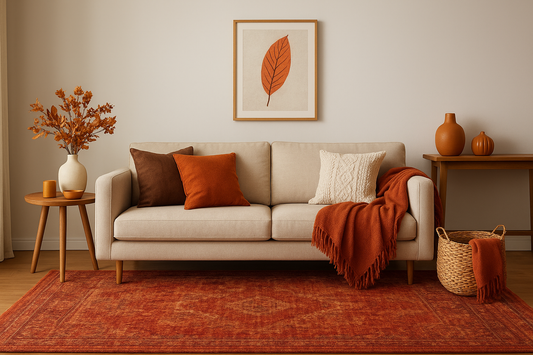Rugs do more than cover floors—they define space, set tone, and reflect personality. One of the biggest choices you’ll face when selecting a rug is whether to go geometric or organic in pattern.
At USTIDE, we offer a wide range of both, because we know that every home—and every homeowner—is different. In this post, we’ll break down the differences between geometric and organic rug patterns, their visual impact, and how to decide which is right for your space.
1. What Are Geometric Rug Patterns?
Geometric rugs are defined by structured, repeating shapes—think diamonds, hexagons, stripes, chevrons, and grid patterns.
Characteristics:
-
Symmetrical and orderly
-
Clean lines and sharp angles
-
Often bold and graphic
-
Easily aligned with furniture or architectural elements
Popular styles:
Modern, Scandinavian, mid-century, urban industrial, and even Art Deco spaces often favor geometric rugs.
Visual impact:
Geometric rugs bring a sense of structure and clarity. They can:
-
Anchor a room with precision
-
Add rhythm and visual balance
-
Create the illusion of movement or direction
2. What Are Organic Rug Patterns?
Organic patterns are inspired by nature—featuring flowing shapes, curves, florals, abstract motifs, or hand-drawn elements.
Characteristics:
-
Asymmetrical or freeform
-
Soft edges, unpredictable forms
-
Evoke natural elements like leaves, water, clouds
Popular styles:
Boho, cottagecore, coastal, wabi-sabi, and eclectic interiors typically embrace organic patterns.
Visual impact:
Organic rugs promote a sense of relaxation and warmth. They:
-
Soften architectural edges
-
Add texture and personality
-
Feel spontaneous and less formal
3. Choosing Based on Interior Style
| Interior Style | Best Pattern Type | Why It Works |
|---|---|---|
| Minimalist | Geometric | Clean lines support simplicity and order |
| Bohemian | Organic | Natural, free-flowing shapes enhance creativity |
| Modern/Urban | Geometric | Strong patterns contrast sleek surfaces |
| Farmhouse/Cottage | Organic | Rustic textures and florals feel authentic |
| Traditional | Geometric or Organic | Persian or oriental rugs often blend both styles |
| Artistic/Eclectic | Organic | Abstract or painterly rugs reflect personality |
4. Room Function Matters Too
-
Living Rooms:
Geometric patterns can create visual definition in large, open spaces. Organic designs offer softness and comfort for lounging zones. -
Bedrooms:
Organic patterns feel calming and cozy—ideal for creating a restful retreat. -
Dining Rooms:
Geometric rugs help frame a table and provide symmetry in layout-heavy rooms. -
Home Offices:
Structured, geometric rugs can promote focus and professionalism.
5. Size and Scale of Pattern
-
Large-scale patterns (whether geometric or organic) make bold statements and work well in spacious rooms.
-
Small-scale patterns are subtle and better suited for compact spaces or layering.
USTIDE tip:
Match pattern scale with room size and furniture arrangement. Too large a pattern can overwhelm; too small can feel lost.
6. Color and Texture Influence
Both geometric and organic patterns come in a variety of colors and weaves:
-
A neutral-colored geometric rug works well in a minimal or modern home.
-
A multicolored organic rug adds vibrancy and visual interest in eclectic interiors.
-
Textured or hand-tufted organic patterns can mimic nature’s irregularity and enhance coziness.
-
Flatweave geometric rugs feel sleek and contemporary.
7. Mixing Both Patterns
Good news—you don’t have to choose one or the other!
Mixing geometric and organic elements is a hallmark of well-balanced interior design. Try pairing:
-
A geometric rug with curvy furniture and round accessories
-
An organic rug with a sharp-lined coffee table or angular lighting
-
Layering a neutral geometric base with a soft, textured organic rug on top
This approach creates visual tension and harmony, making spaces more dynamic.
Conclusion: Let Your Rug Reflect You
When it comes to rug patterns, there’s no single “right” choice—only the one that fits your space, your style, and your personality.
-
Choose geometric if you want structure, boldness, and a contemporary edge.
-
Choose organic if you seek softness, nature-inspired warmth, and creativity.
-
Or, combine both for a layered, designer-curated look.
At USTIDE, we offer both styles in a range of materials, colors, and techniques—each one carefully crafted to help you build a space that feels uniquely yours.





